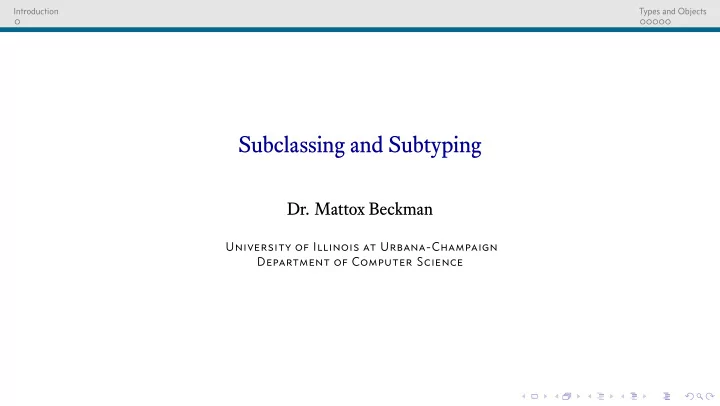

Introduction Types and Objects Subclassing and Subtyping Dr. Mattox Beckman University of Illinois at Urbana-Champaign Department of Computer Science
Introduction Types and Objects Objectives You should be able to ... The idea of a subtype and a subclass are very closely related, but there is a subtle difference we would like to cover. ◮ Explain the difference between a subclass and a subtype. ◮ Explain the terms covariant and contravariant . ◮ Identify if two types have a subtyping relationship.
An integer is a kind of fmoat, so we can say that integer is a subtype of fmoat. Introduction Types and Objects How do Types Relate? ◮ How can you tell if one type is a subtype of another? ◮ Are integers subtypes of fmoats? (Or vice-versa?) ◮ Characters / strings? ◮ Squares / shapes?
Introduction Types and Objects How do Types Relate? ◮ How can you tell if one type is a subtype of another? ◮ Are integers subtypes of fmoats? (Or vice-versa?) ◮ Characters / strings? ◮ Squares / shapes? ◮ An integer is a kind of fmoat, so we can say that integer is a subtype of fmoat. Float Int
Introduction Types and Objects Covariance ◮ Some types take parameters, such as lists and trees. ◮ If the subtype relationship varies according to the input type, the type is said to be covariant . ◮ “Most” types containing parameters are covariant. [Float] Float [Int] Int
Introduction Types and Objects Functions ◮ Functions are an important exception! ◮ The function type is covariant with respect to the output. If we are expecting a function that outputs a fmoat, I can give you a function that outputs an integer without breaking anything. The reverse is not true! ◮ The function type is contravariant with respect to the input. If we are expecting a function that takes a fmoat, providing a function that takes an integer will fail or truncate the input. Int → Float Int → Int Float → Float Float → Int
} public class A { } Introduction Types and Objects The Trouble with Objects ... Actually, there’s more than just this one! 1 2 public A foo( A x ) { ... } 3 public A bar() { /* calls foo ... */ } 4 5 public class B : A { 6 public B foo( B x ) { ... } 7 ◮ B.bar inherits from A . ◮ But B.foo overwrites A.foo . ◮ When A.bar calls B.foo , what will happen?
Introduction Types and Objects Conclusions ◮ Objects have a lot of fmexibility and allow us to create useful abstractions. ◮ They can be implemented using functions. Users of functional programming languages tend to avoid them. ◮ These are useful enough in practice, and diffjcult enough to implement, that most modern languages now include them, including OCaml. (That’s where the O comes from.) ◮ Inheritance can be tricky.
Recommend
More recommend